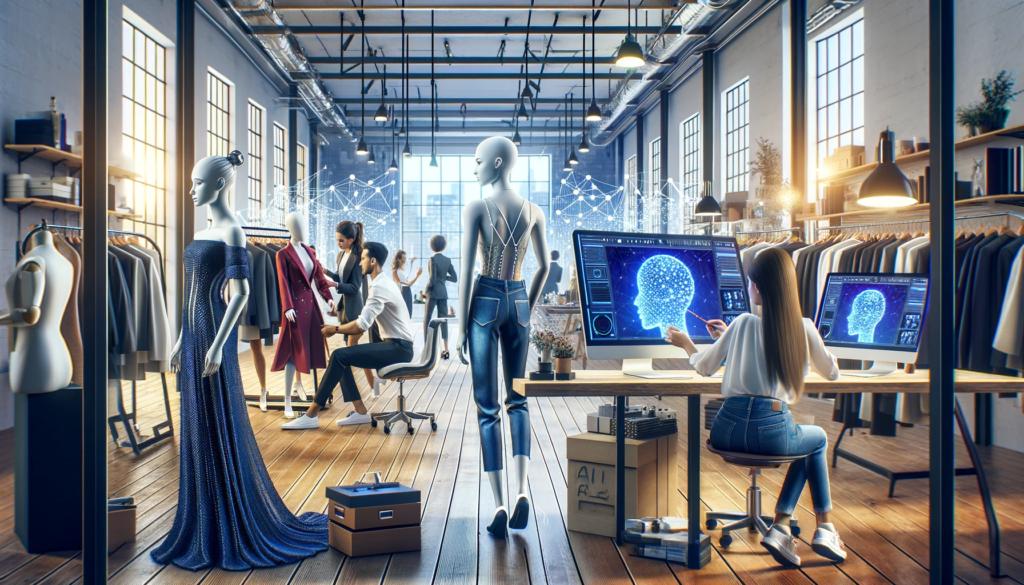AI in Fashion Design
Artificial Intelligence is transforming the fashion industry leading to innovations in both design and retail activities. AI revolutionizes how designers create, how trends are predicted and how retailers manage their stock and interact with consumers with the analysis of large datasets and automated processes (Luce, 2018). In this blog, we’ll explore how AI is being applied across various stages of the fashion ecosystem, from creative design to personalized shopping experiences.
Using AI, designers blend technology and creativity. Machine learning alogrithms allow designers to analyze historical trends, consumer preferences and data to generate new or innovative designs. Fashion houses like Alexander McQueen have begun to incorporate AI into their design processes. This allows for experimenting with new styles and materials (Renee, 2023). In addition, AI contributes to sustainable fashion by helping brands reduce waste and optimize material choices, and production processes.
Trend Forecasting with AI
Predicting fashion trends has traditionally been a complex and instinct-driven process, but AI is providing brands with more accurate and data-driven insights. Machine learning algorithms scan social media platforms, online influencers, and sales patterns to identify emerging trends. Companies like Heuritech use AI to analyze millions of images on Instagram to predict future fashion trends months ahead of time (Poncelin, 2024). Brands react more quickly to consumer demands, reduce overproduction and meet better the market expectations due to the advanced forecasting.
AI-Driven Inventory Management
Inventory management is another area where AI is making a significant impact. AI systems can process vast amounts of sales data, seasonal trends, and even weather forecasts in order to help retailers optimize stock levels. AI helps brands maintain the right balance between supply and demand so that the chances of overstocking or stockouts are significantly reduced. Major fashion retailers like Zara and H&M have embraced AI to manage their inventories which leads to more efficient supply chains and less waste (Ünal et al., 2023). Therefore, retailers can ensure that popular items remain available while minimizing markdowns and unsold inventory.
Personalized Shopping Experiences
AI is enhancing the shopping experience by providing personalized recommendations and services tailored to individual customers. Retailers like ASOS and Stitch Fix use AI-powered recommendation engines and virtual stylists to analyze customer preferences and browsing behaviors. That way they deliver product suggestions uniquely suited to each shopper’s style (Fix, 2023). This personalization simultaneously improves customer satisfaction and helps retailers build stronger customer loyalty and increase sales.
AI is transforming the fashion industry by bringing innovation to design, trend forecasting, inventory management, and retail experiences. Brands that adopt AI technologies are staying ahead of consumer demands and improving efficiency and sustainability. As AI continues to advance, its role in fashion will only expand and lead to shaping the future of the industry in innovative ways.
References:
- Luce, L. (2018). Artificial Intelligence for Fashion: How AI is Revolutionizing the Fashion Industry. https://link.springer.com/content/pdf/10.1007/978-1-4842-3931-5.pdf
- Renee, K. (2023, December 15). How Artificial Intelligence is Revolutionizing the Fashion Industry. RYN. https://www.therynapp.com/post/how-artificial-intelligence-is-revolutionizing-the-fashion-industry
- Poncelin, C. (2024, June 28). How Heuritech forecasts fashion trends thanks to AI. Heuritech. https://heuritech.com/articles/how-heuritech-forecasts-fashion-trends-thanks-to-artificial-intelligence/
- Ünal, Ö. A., Erkayman, B., & Usanmaz, B. (2023). Applications of Artificial Intelligence in Inventory Management: A Systematic Review of the literature. Archives of Computational Methods in Engineering. https://doi.org/10.1007/s11831-022-09879-5
- Fix, S. (2023, June 29). How We’re Revolutionizing Personal Styling with Generative AI – Stitch Fix Newsroom. Stitch Fix Newsroom. https://newsroom.stitchfix.com/blog/how-were-revolutionizing-personal-styling-with-generative-ai/


I enjoyed reading this blog post! For me, it’s exciting to learn more about how AI has been transforming the fashion industry over the past few years. Having worked in the fashion world myself for three years, I can’t tell you how many times I found myself stuck doing time-consuming tasks that could’ve been finished much faster and effectively with the help of AI automation. Using machine learning algorithms to help professionals analyze historical trends, consumer preferences, and data is helpful to any industry, but it feels especially game-changing in fashion. As you mentioned, AI-driven inventory management is a total breakthrough. Most fashion companies struggle to optimize stock levels, and maintaining the balance between supply and demand puts a lot of pressure on the supply chain. AI helps reduce the risk of overstocking or running out of stock, which is crucial for making businesses more cost-efficient and ensuring smoother operations. Plus, it’s great to see how it can keep popular items in stock while cutting down on markdowns and leftover inventory. This breakthrough in inventory management could really help make the fashion industry more sustainable in the long run.